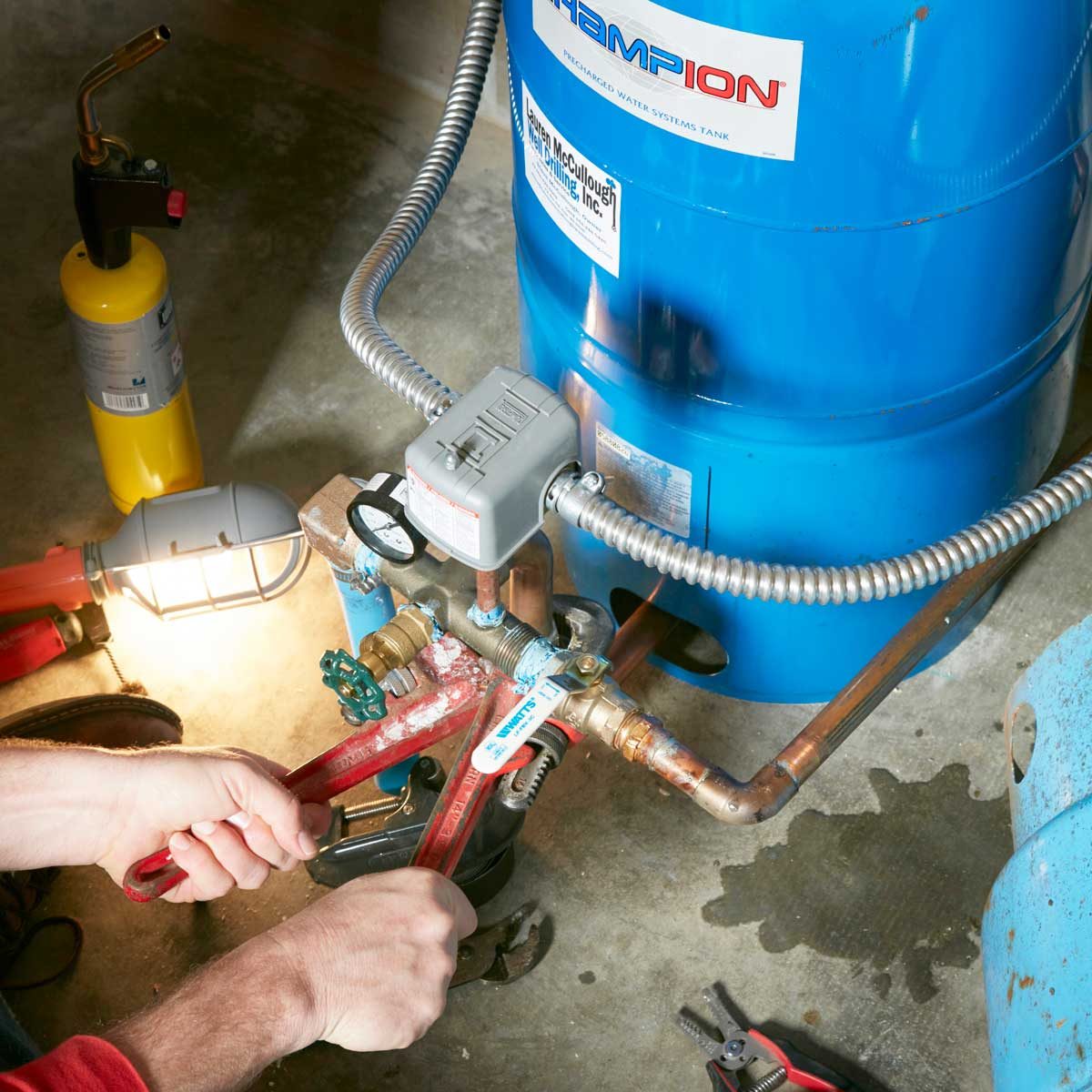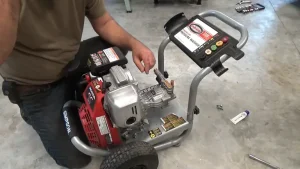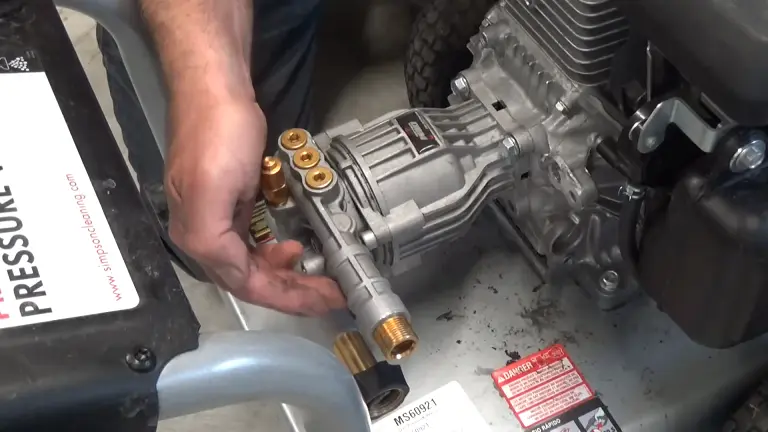To replace washers in the top of a well pump, first turn off the power and drain the system. Next, disassemble the pump head to access and replace the washers.
Dealing with a malfunctioning well pump can be a daunting task for many homeowners. The heart of the issue often lies in worn-out washers that compromise the pump’s efficiency and water flow. Tackling this problem promptly not only ensures a steady water supply but also extends the life of your well pump.
This guide is designed to demystify the process, making it accessible even to those with minimal plumbing experience. Understanding the steps involved in replacing the washers at the top of your well pump can save you time and money, avoiding the need for professional intervention for such a manageable task. Follow along for a straightforward approach to maintaining your well pump’s optimal performance.

Credit: www.amazon.com
Tools Needed for Replacing Washers in Top of Well Pump
Having a well pump means being ready for maintenance. One common issue is a leaking pressure valve. Replacing washers can fix this problem. You will need certain tools to start. This guide will tell you about those tools. Let’s fix that well tank pressure relief valve leaking issue!
Basic Tools
Before you learn how to replace pressure relief valve on well pump, gather these tools:
- Adjustable Wrench: To loosen and tighten nuts.
- Screwdriver Set: For screws on the pump cover.
- Replacement Washers: The main parts you’ll change.
- Pipe Wrench: To hold pipes while you work.
- Plumbers Tape: Helps seal threads after fixing.
- Bucket: Catch any water that drips out.
Turn off power to the pump before you start. Make sure you have the right washer size. Carefully remove the old washer. Place the new washer in the same spot. Check the pressure valve for any other issues. It’s time for the new washer to do its job!
Safety Equipment
Working on a pressure valve for well pump can be risky. Protect yourself with these items:
| Equipment | Use |
|---|---|
| Gloves | Protect hands from sharp edges and dirt. |
| Safety Goggles | Keep your eyes safe from any debris. |
| Ear Protection | For loud noises from the pump or tools. |
| Boots | Prevent slips and protect your feet. |
Wearing the right gear is super important. Gloves and goggles are a must. They stop you from getting hurt. Ear protection keeps loud sounds from hurting your ears. Boots keep you from slipping. Always be safe, not sorry!

Credit: www.familyhandyman.com
Identifying Problems
Replacing washers in a top of well pump is a crucial maintenance task. Over time, washers can wear out, leading to problems with the pump’s performance. Understanding the signs of washer issues and properly diagnosing them are key steps to ensuring your well pump operates smoothly. Tackling these problems early on can save time and prevent more serious issues with your water system.
Common Signs
Spotting the warning signs of worn-out washers can be straightforward. Look for these clues:
- Decreased water pressure: A sudden drop may suggest a washer problem.
- Water leaks: Puddles or damp areas near the pump might indicate a failing washer.
- Noisy operation: Unusual sounds from the pump can be a sign of internal issues.
- Short cycling: The pump turning on and off too frequently is another red flag.
Regular inspections can help catch these signs early. This way, you can replace washers before further damage occurs.
Diagnosing Issues
A detailed inspection can help you find out if your washers need replacing. Follow these steps:
- Turn off the power to your well pump.
- Release pressure in the system by opening a faucet.
- Inspect the pump for visible signs of wear or damage.
- Listen for irregular sounds when the pump is running.
Use these steps to check the well pump’s washers. Taking notes of what you find can be very helpful. Remember, it’s best to fix problems quickly to keep your water flowing right.
Preparing For Replacement
A well pump is vital for getting water from the ground to your home. Over time, parts like washers wear out. Knowing how to replace them is key. This guide will help you prepare for the task. You’ll learn how to safely shut off power and drain water. These steps are crucial for a successful washer replacement.
Shutting Off Power
Turn off the electricity before working on your well pump. This is a safety must. Find your home’s main power panel. Look for a switch labeled ‘well’ or ‘pump’. Flip it to the ‘off’ position. To be extra safe, remove the fuse that controls the well pump circuit.
Use a non-contact voltage tester to check for power. Touch it to the pump’s wires. No light or beep means the power is off. Always double-check. This ensures you’re safe to proceed. Remember, electricity can harm you. Never skip this step.
Draining Water
With power off, you must drain water from the system. Start by locating the pump’s drain plug. It’s usually at the pump’s base. Place a bucket underneath. This catches any spilling water. Now, carefully unscrew the plug.
Water will start to flow out. Let it drain completely. This might take a few minutes. While waiting, check the hoses. Make sure they’re not kinked or blocked. Clear water paths help prevent messes. Once all water is out, you’re ready for the next step.
Disassembling The Pump
Replacing washers in the top of a well pump is a key maintenance task. It ensures your pump works well and lasts longer. This guide will help you understand how to disassemble the pump. You’ll learn step-by-step how to get to and change these small but vital parts. Remember, safety is important. Always turn off the power before you start any work on your pump.

Removing The Cover
To start, you’ll need to remove the pump’s cover. This may seem simple, but it’s very important. First, make sure the power to the pump is off. This keeps you safe. Then, find the screws or bolts that hold the cover in place. You might need a screwdriver or a wrench. Keep all screws in a safe place so you don’t lose them.
Here’s what to do:
- Locate all fasteners on the cover.
- Use the right tool to loosen each one.
- Lift the cover off carefully.
- Check the cover for any signs of wear or damage.
If you find dirt or debris inside, clean it out gently with a cloth. Be gentle with wires and other parts inside.
Taking Out Old Washers
With the cover off, you can now reach the washers. These washers help prevent leaks. Over time, they can wear out. Identify the washers that need replacing. They are usually made of rubber and are flat or rounded.
Use these steps:
- Find the washers on the pump head.
- Notice how they fit and what holds them in place.
- Use pliers or a similar tool to remove the old washers.
- Be gentle to avoid damage to other pump parts.
Once removed, inspect the area where the washers sat. Make sure it’s clean and free of any damage. If there’s build-up, wipe it away with a clean cloth. This helps the new washers seal properly.
Choosing New Washers
Knowing how to replace washers in the top of a well pump is vital. It ensures your pump works smoothly. This guide will help you choose the right new washers.
Material Options
Washers come in various materials. Each one suits different needs. Let’s explore the options:
- Rubber: Great for general use. Rubber is flexible and seals well.
- Silicone: Perfect for high temperatures. Silicone lasts longer than rubber.
- Metal: Best for heavy-duty tasks. Metal washers handle more weight and pressure.
- Plastic: Good for less stress areas. Plastic is cheaper but not as durable.
Each material has its pros and cons. Think about your well pump’s needs before choosing.
Sizing Considerations
Size is key for the right fit. A wrong size can cause leaks. Here are steps to pick the correct size:
- Measure the old washer’s diameter.
- Check the thickness. Thicker washers seal better but need more space.
- Consider the inner diameter for a snug fit around the pump.
Tip: Always double-check measurements before buying new washers. This ensures a perfect fit and avoids water leaks.
Installing New Washers
Many homes use a well pump for water. Sometimes, these pumps need new washers. Replacing washers in the top of a well pump helps it work better. This guide talks about how to install new washers correctly.
Placement Tips
Finding the right spot for new washers is key. Washers help stop leaks in the pump. Follow these steps:
- Turn off the pump before starting.
- Remove the pump’s top to see inside.
- Take out the old washer. Notice its spot.
- Place the new washer exactly where the old one was.
- Make sure it sits flat and even.
Not all washers look the same. Choose the right size and shape for your pump. This makes sure it fits well and works right.
Securing Components
After placing the washer, securing it is important. This means making sure everything is tight and in place. Here’s how:
- Tighten screws or bolts that hold the top on. Not too tight!
- Check the washer by gently pressing. It should not move.
- Reconnect any wires or tubes you had to remove.
- Turn the pump back on and listen. No strange noises should be heard.
Doing this right keeps your pump safe from damage. Always double-check your work.
Reassembling The Pump
Maintaining a well pump is key to a steady water supply. Over time, washers inside the pump can wear out. It’s important to replace these washers to keep the pump working well. This guide will show you how to put a well pump back together after changing the washers. We will also go through some final checks to make sure everything is set up correctly.
Putting It Back Together
Reassembling a well pump is like solving a puzzle. Every piece must fit in the right place. Follow these steps to put your pump back together:
- Start by placing the new washers where the old ones were.
- Next, put the impeller back on its shaft. Make sure it spins freely.
- Reattach the diffuser over the impeller.
- Place the seal plate and screw it tightly.
- Connect the motor to the seal plate. Make sure all bolts are tight.
- Reconnect any wires that you disconnected before.
Take your time and be gentle. Every part is important for the pump to work right. If you force a part, it can break.
Final Checks
Before you use the pump again, do these checks:
- Make sure all the parts are secure and in place.
- Look for any tools or parts left inside the pump.
- Check the pump’s pressure settings.
- Fill the pump with water before you turn it on.
- Listen for strange noises when the pump starts.
- Watch for any leaks around the new washers.
Remember, safety is very important. Always turn off the power before you touch the pump. If the pump works well and there are no leaks, you did a great job!
Testing The Pump
Washers in well pumps ensure a tight seal and prevent leaks. Over time, they can wear out. Checking and replacing these parts is vital for a well-functioning pump. This guide focuses on how to test the pump after replacing washers.
Powering Up
Before starting the pump, ensure all connections are secure. This is crucial for safety and function. Follow these steps to power up your well pump:
- Check the power source to confirm it is off before beginning.
- Inspect the wiring for any signs of wear or damage.
- Replace any damaged components before proceeding.
- After ensuring all connections are secure, turn on the power.
- Listen for any unusual noises that might indicate a problem.
- Observe the system pressure gauge to ensure it climbs steadily.
Monitoring Performance
Keep an eye on how the pump behaves after powering up: Watch the pressure gauge and listen. A well-functioning pump should not make strange noises. Check for leaks around the new washers. Note any drops in pressure that could signal an issue.
A table can help track performance over time. Record the pressure at regular intervals. Look for consistent readings. Any big changes might mean more work is needed.
Add more rows as necessary for ongoing monitoring.
| Time | Pressure Reading |
|---|---|
| 0 min | Check initial pressure |
| 10 min | Record second reading |
| 20 min | Compare with previous |
FAQs
Fixing a well pump can sound tough. But, with the right steps, it’s easy! This guide shows you how to stop leaks by replacing washers. Let’s dive into common questions and make your well pump as good as new!
Why Is My Well Pump Leaking Water?
A well pump may leak for a few reasons. Often, a worn-out washer is the culprit. Rubber washers can break down over time. This causes water to escape where it shouldn’t. Checking these parts and replacing them can stop the leaks.
How To Remove A Well Cap Cover?
Taking off a well cap cover can be simple. Just follow these steps:
- Turn off the power to the pump.
- Use a wrench to loosen the bolts on the cap.
- Carefully lift the cap off the well casing.
How Do I Bleed The Air Out Of My Well Water System?
Air in your system can cause trouble. To bleed it out, try these steps:
- Turn off your pump and open a faucet.
- Wait for water and air to come out.
- Once only water flows, close the faucet.
- Turn the pump back on.
How Do You Know When Your Well Pump Needs To Be Replaced?
There are signs to look out for. If you notice strange noises, low water pressure, or dirty water, it might be time for a new pump. Also, check if the pump runs non-stop or starts and stops too often.
What Is The Average Life Of A Well Pump?
A well pump’s life can vary. Typically, pumps last around 8 to 15 years. Yet, this depends on the pump model, water quality, and how well it’s maintained.

Credit: m.youtube.com
Conclusion
Wrapping up, replacing washers on your well pump need not be daunting. With the right tools and steps, you can ensure a leak-free system. Remember, regular maintenance keeps your water supply running smoothly. Ready to tackle the next home repair?
Your trusty well pump awaits!

